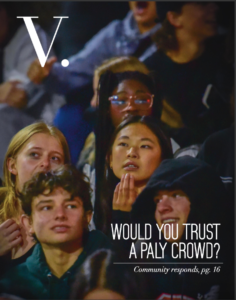From the editors: Defining Paly
One day in the future, when we sit back and conjure up old memories of this semester of high school, many of us may think of a single defining moment: the rush of Palo Alto High School students to our hometown rival’s bleachers at the Sept. 9 football game — and the fallout from administrators that followed.
Whether you ran into the Gunn High School bleachers with dozens of your peers or spent that Friday night elsewhere, the odds are that the event seeped into your school life, either in the form of a dramatic lunchtime discussion with friends or seeing the schoolwide Schoology posts.
In the days and weeks that followed the football game, many questions were raised by the Palo Alto community about what kind of people Paly students are. Are they rowdy or spirited? Did their actions reflect a lack of responsibility or were they just teens being teens? What is their reputation within the greater Palo Alto community?
In his video broadcast to the school, Principal Brent Kline said that the rush tarnished that reputation.
“We need to work together to end this inappropriate and disruptive tradition of behavior and help you understand the impact of this negative behavior on our community and particularly our school,” Kline said in the video.
Our verdict? It’s not necessarily black and white. In our cover story, Managing Editor Andrew Xue went around Palo Alto to ask community members one question: “Would you trust a Paly crowd?” We hope the 20 responses add different perspectives to the dialogue about what the Paly community values.
But, of course, the issue doesn’t stop at this feature.
As we consider who Paly is — both as a whole and as individuals — Asian American artist Ruth Asawa’s exhibit showcasing a sea of clay masks makes us wonder how our personal identity changes when we join a larger group. Each mask was cast from a unique person’s face, but when displayed together, do viewers appreciate the intricacy of each one or just see them as pieces of a whole?
Social Media Manager Austin Eng and staff writer Asha Kulkarni explored the exhibit and the essential lessons about the diversity of individuals and communities that Asawa and her art can teach us, in “Changing the face of art.”
“Hidden hero,” by Features Editor Alexis Chiu, will introduce you to Veronica Rodriguez — the person who has printed nearly every handout we have received from our teachers during our time at Paly. Rodriquez’s behind-the-scenes role is not recognized enough and Chiu’s profile reminds us that the Paly community is much more than just the student body.
In the perspectives section, Kulkarni and Perspectives Editor Andy Robinson dig into the changing nature of politics. Kulkarni challenges the widespread narratives surrounding Vice President Kamala Harris in “Reframing Kamala Harris,” and Robinson offers a way for the Democratic party to define its values and goals in a new political climate.
Our adviser, Paul Kandell, often references a quote on the wall of our MAC105 classroom: “Comfort the afflicted and afflict the comfortable.” We hope that this issue will do just that. After all, that’s our job as student journalists.
On the cover
 A group of student onlookers are pictured on the Palo Alto High School bleachers at its Nov. 11 league football game against Stevenson School, almost 2 months after an incident at Paly’s football game against Gunn High School that sparked debate about sportsmanship and reputation. This photo was taken by Managing Editor Andrew Xue, who, for this issue’s cover story, asked 20 Paly community members whether they would trust a crowd of students.
A group of student onlookers are pictured on the Palo Alto High School bleachers at its Nov. 11 league football game against Stevenson School, almost 2 months after an incident at Paly’s football game against Gunn High School that sparked debate about sportsmanship and reputation. This photo was taken by Managing Editor Andrew Xue, who, for this issue’s cover story, asked 20 Paly community members whether they would trust a crowd of students.



